Tech cards, situational cards that are strong against specific decks, have traditionally been very powerful in Hearthstone. Notable examples from the past include Golakka Crawler decimating Pirate decks and Skulking Geist completely erasing one of Jade Druid’s win conditions by removing Jade Idols and preventing the Jade Druid from going infinite.
Alas, such cards always come at a cost. Skulking Geist, for example, is a terrible card in matchups where you do not want to destroy the opponent’s one-mana spells. A 4/6 minion for six mana? That’s one bad deal. Therefore, it is always a balancing act to get the incredible value tech cards can offer while not hurting your deck too much in matchups where they are irrelevant. Furthermore, simply having a great tech card in your deck does not mean that you’re always going to win against its target: you also need to draw that particular card, and that does not happen in every game. Even the best tech cards are only an improvement, not a panacea.
Things get even trickier when the meta is diverse. What will you tech against? How much value does the tech card need to provide to be worth including in the deck? Facing a Jade Druid in a quarter of your games may have made teching against it a no-brainer, but The Witchwood meta is far more diverse than most Hearthstone metas have been: currently, no archetype comes even close to 10% of the field, which makes teching against any individual archetype difficult.
You may be able to exploit temporary shifts – people trying out a new deck played by a popular streamer or seen in a tournament – but those last only for a day or two. For the most part, your deck needs to be able to answer a large variety of challenges, and your tech cards need to be able to answer a diverse field.
Let’s take a look at the available options and how they are doing in The Witchwood!
Silence and Transformation Effects

Silence and transformation effects are usable in a wide variety of matchups and they are extremely popular, to the point where they could even be considered core cards in decks rather than tech choices. In general, transformation effects are more powerful than silence effects, as they completely remove the minion from the resurrection pool, hurting decks such as Cubelock and Taunt Druid in ways a simple silence cannot achieve.
Therefore, classes that have access to transformation effects – Polymorph for Mage and Hex for Shaman – go for those effects first and foremost. It is almost impossible to find a Shaman list that does not run Hex, as it fits both Even Shaman and Shudderwock Shaman. Polymorph sees somewhat less play in Mage, but it is universally included in Big Spell Mage decks, and omitted from the more aggressive Tempo Mage decks that have a ton of direct damage – they do not worry about silencing the opponent’s minions, when they can just target face directly. It is interesting to note that Tempo Mage decks sometimes include a single copy of Spellbreaker: it can help push minion damage for one additional turn while developing a body on the board, therefore fitting the aggressive strategy better than Polymorph.
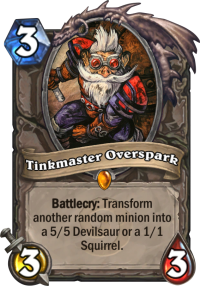
There is also a neutral transformation effect: Tinkmaster Overspark. However, Tinkmaster is difficult to use effectively, as it transforms a random minion, which can also be one of your own. If you can isolate the target on the board, it is great, but that is difficult to accomplish with most decks. It is powerful against Taunt Druid in particular and sometimes against Cubelock, but in just about all other matchups it is inferior to a simple silence effect, which is why it has not managed to become popular.
The use of transformation effects is interesting. For example, against Taunt Druid, it might look like Hadronox is the primary target, but it isn’t – you’ll never get a chance to Polymorph Hadronox unless you can get rid of Naturalize first, for example with Skulking Geist. More often, it is The Lich King that you want to get rid of to ensure that Hadronox cannot bring it back again and again. Likewise, you rarely want to silence Hadronox – it is going to come back later anyway, and silencing it only helps if you can prevent it from dying fast. Most of the time, you’re looking to silence Carnivorous Cube to prevent additional copies of Hadronox or other minions.
While Polymorph and Hex have seen universal play in their appropriate archetypes all along, the fortunes of silence effects have varied: Spellbreaker used to be in around 40% of decks in the pre-nerfs Witchwood meta, but it has fallen down to around 20% of decks in the post-nerfs meta. Ironbeak Owl has come down from around 15% to around 10% of decks. Meanwhile, the use of Priest-specific Mass Dispel and Silence remains steady.
Superficially, it appears that silence effects are less useful now than before, but this perception is more apparent than real. The real reason for the decline in the numbers of Spellbreaker and Ironbeak Owl is not that silence is less useful, but that archetypes that have other answers are more popular: Shaman with Hex, Miracle Rogue with Sap, Taunt Druid that cannot use these cards because of Oaken Summons, and Taunt Warrior that has a hard time fitting in any tech cards are all much more popular now.
If anything, there is an interesting trend in Shudderwock Shamans. They are adding in two copies of Earth Shock in addition to two copies of Hex into the deck. That’s a total of four silence or transformation effects in the deck!
Overall, silence and transformation effects continue to be very useful in the post-nerfs Witchwood meta, and it is advisable to use at least one slot for such an effect in almost all decks. Some decks use up to four, but it depends on the archetype and what you are facing – in my own testing, even two silence effects has been too much in some cases.
Weapon Removal

In the pre-nerfs Witchwood meta, almost two-thirds of decks included some form of weapon removal. After the nerfs increased the popularity of non-weapon classes and reduced the numbers of Cubelocks (Skull of the Man'ari being the prime weapon removal target), weapon removal techs became less common. Currently, around one-third of decks run some form of weapon removal.
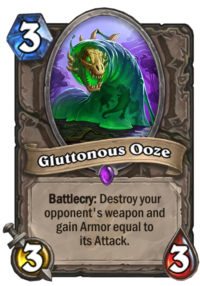
The most popular weapon removal card at the moment is Gluttonous Ooze – while its stats are not great, its additional function to give armor makes it a powerful option for control decks that attempt to defend themselves against aggression.
The other common option is Acidic Swamp Ooze. It has a better statline for its cost and it is a little cheaper, so you can more easily combine other cards alongside it, and it is also the only even-cost option for Genn Greymane decks.
Harrison Jones also sees play in a variety of decks – typically in classes that have a hard time drawing cards, as it allows you to combine weapon removal and card draw.
Finally, there is Corrosive Sludge. It is a fairly expensive weapon removal piece, but its cost can also be an advantage, because it cannot accidentally be recruited with Oaken Summons. It sees play mostly in some Druid decks that want to run Oaken Summons, want to have weapon removal, but already have all the card draw they need in the form of Ultimate Infestation, so they do not want to run Harrison Jones.
The weapon removal options in Standard format right now are comprehensive, there is something for everyone. You can get your weapon removal cheap, or you can get some armor with it, or some card draw, or you can get it at a mana cost that does not ruin your Recruit cards.
Do you need it? Roughly half of the decks in the meta have some weapons in them, and some of them are very powerful, such as Skull of the Man'ari and Vinecleaver. That said, weapons are not quite as common as they used to be, so weapon removal is an edge case, as can be seen by its waning popularity. It still remains the second-most popular tech after silence and transformation effects.
Skulking Geist
Skulking Geist is a peculiar card. Created to stem the flood of Jade Druids, it has become a common tech card that can shut down various other strategies as well and continues to find uses even after Jade Druids are long gone from the Standard format. The popularity of Skulking Geist was hardly affected by the nerfs: it maintains a steady representation of around 10% of decks.
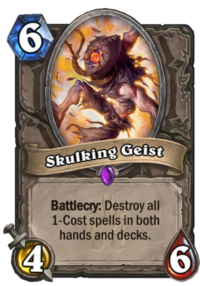
In the post-nerfs Witchwood meta, there are still several good targets for Skulking Geist:
- Taunt Druid: Naturalize, Lesser Jasper Spellstone
- Cubelock: Dark Pact
- Odd Paladin: Lost in the Jungle, Blessing of Might
- Miracle Rogue / Odd Rogue: Cold Blood, Deadly Poison
- Recruit Hunter / Spell Hunter: Play Dead, Hunter's Mark, Tracking, Arcane Shot
- Combo Priest: Inner Fire
- Taunt Warrior: Shield Slam
Depending on the matchup, Skulking Geist can disrupt the opponent’s core plan (Taunt Druid, Cubelock, Combo Priest, Recruit Hunter), reduce their burst damage (Odd Paladin, Miracle Rogue, Odd Rogue), or reduce their removal options (Spell Hunter, Taunt Warrior).
In some cases, it can actually be detrimental to play Skulking Geist, because removing weak cards from the opponent’s deck means that they are more likely to draw their good cards. In other cases, however, disrupting the opponent’s main plan is extremely important and Skulking Geist should be played as soon as possible.
Mind Control Tech

Mind Control Tech is a tech card that has seen some use whenever board flooding is common: the more decks in the meta that like to go wide on the board, the better Mind Control Tech is. Nerfs did not really benefit Mind Control Tech, and its use has fallen from around 14% to around 9% of decks.
Mind Control Tech sees play mostly in Shudderwock Shaman and Spiteful Druid, where it can help with mid-game board control, occasionally grabbing something big to really swing the game. In Shudderwock Shaman it has the additional benefit of activating from Shudderwock, making it more difficult for the opponent to deliver a lethal blow before the final turn.
The Black Knight
With The Lich Kings roaming all over the place, can this classic anti-Taunt tech card make a comeback? Unlikely, but it is a growing presence, from around 0.5% of decks pre-nerfs to around 3% right now. If you don’t like Taunt minions and want to develop a medium-sized minion of your own while taking one out, he’s your man.
Abomination
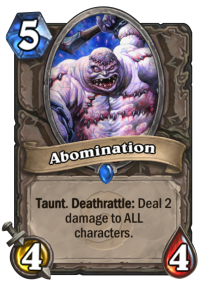
One of the newcomers to the tech card scene in The Witchwood, Abomination is a Classic set card that has never really found its place – until Token Druid became a thing. In the current meta, teching against a single archetype is questionable at best, but some decks can still benefit from such a move.
Abomination sees some play in Big Spell Mage and Quest Priest, two control archetypes that find it difficult to answer the token + Soul of the Forest board of Token Druid. Abomination solves the problem neatly by dealing with the first board and then allowing a single area-of-effect damage spell to deal with the Treants from Soul of the Forest.
Big Game Hunter
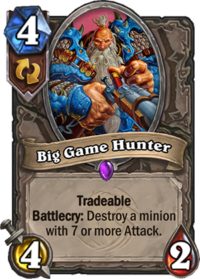
With the rise of Even Warlock and its early Mountain Giants, things should potentially look good for Big Game Hunter to hunt them down. However, its popularity has actually gone down since the nerfs and Big Game Hunter currently appears in less than 1% of decks.
This showcases how difficult it is for a tech card to make it in The Witchwood. Even Warlock is one of the most popular decks, but no deck is so popular that teching against it at the expense of other matchups is advisable. There are many matchups where Big Game Hunter cannot be used at all, so the cost is too big. It would have to have at least some use in more matchups to become popular.
Cornered Sentry

Do you play Warrior? Do you hate Taunt Druid? If you answer both questions with a resounding yes, you want a Cornered Sentry in your deck. Unless you play Odd Warrior, then you just have to hope you can pick one up from Stonehill Defender.
The Raptors summoned by Cornered Sentry are beasts and can really mess up Taunt Druid’s Witching Hour, but it is not a bad card even without that upside, as it combines very well with Brawl, Drywhisker Armorer, and any Whirlwind effects. The presence of Taunt Druid is just the final upside the card needed to make it into most Warrior decks.
Mossy Horror

Mossy Horror is a tech card just waiting for the right meta, which, admittedly, might never come. It’s neutral, so it gives a removal option to any class, but finding enough small minions to target is a problem. Warlock can somewhat alleviate the issue with Curse of Weakness, but the two-card late-game combo faces some stiff competition from Twisting Nether. Mossy Horror is not good at dealing with Token Druid’s Soul of the Forest boards either. Maybe one day.
Nerubian Unraveler
Every once in a while, being able to delay your opponent’s spells has been a good thing. Not quite giving them enough time to play that board clear can be the difference between victory and defeat, and Nerubian Unraveler is one of the few cards that enables such interaction in Hearthstone. The Witchwood meta, however, is mostly not dependent on board clear spells, which makes Nerubian Unraveler of limited use – it can make Dark Pact or Naturalize awkward, but you could also just run Skulking Geist to get rid of them altogether.
Tech Cards Without Targets in The Witchwood

Some tech cards that saw play before The Witchwood have fallen completely by the wayside. They are still in the game, and perhaps they will have another chance in the next expansion, but they are unlikely to find any use in The Witchwood:
- The Darkness: Never a real powerhouse, The Darkness nonetheless was able to get some things done by injecting additional cards to the opponent’s deck and thereby rendering cards such as Raza the Chained inactive. In The Witchwood, The Darkness can do no such thing. The Darkness shuffles additional spells into the deck, so it cannot disable Spell Hunter’s effects. It can disrupt Spiteful Summoner, but Spiteful decks are not that popular.
- Hungry Crab: The classic hate card, this anti-Murloc beast has had some good times, especially in Hunter and Druid decks. With Murlocs all but gone from the meta, it sees hardly any play.
- Golakka Crawler: The anti-Pirate fighter sees hardly any play. We’re talking on the level of 0.004% here. Let me know if you were the one who used it in the past 30 days!
- Chief Inspector: Secret removal used to be a thing, but The Witchwood meta is far too diverse and Secrets are too few and far between for it to be worth it right now.
To Tech or Not to Tech?
The current meta is not very tech-friendly, it is simply too diverse. You’d want tech cards that can target multiple popular archetypes and not cost too much in other matchups. Very few decks can afford to tech against a single opponent – Big Spell Mage with Abomination being a rare exception where the inability to handle a specific matchup without a tech card may just barely outweigh the harm it does in other matchups – and Abomination is not completely useless in most other matchups either.
There are some general deck-building choices to be made. For example, Doomsayer was not very good in the pre-nerfs meta, but it is much better now in the slightly slower meta where it can actually clear the board quite reliably early in the game. It is not really a tech card, it does not target any particular type of deck. It is this general deck-building that is emphasized in The Witchwood meta, not individual tech cards. You can argue that it is a good direction for the game, as when a tech card hits just the right spot in Hearthstone, it can have a devastating effect.
Tech cards can still be good for you. Finding just the right balance is difficult, but good meta knowledge can still be rewarded also in the form of right tech choices. It is just more difficult than simply adding Golakka Crawler to all of your decks now.
In this article, I have highlighted the main tech options in the current Standard format. Have you had success with any of them, or do you have some other tech cards that you have found effective? Let me know in the comments!

“Golakka Crawler: … Let me know if you were the one who used it in the past 30 days!”
Yeah, that was me, sorry 😉 Probably doesn’t count as it came from a Jewelled Macaw though.
it still intrigues me how mind breaker never got to be a thing, one could think it can be a good tech for DK and Odd/Even decks with good stats, but still no meta deck has already ran it.
Most of the time, disabling your opponent’s hero power is not worth losing your own. Taunt Warrior’s Hero Power is just about the only one worth taking away, and Taunt Warrior has plenty of ways to kill a minion at that point of the game.
Mind Breaker was popular early in the Witchwood when Odd Paladin, Odd Hunter and Odd Rogue were all over the place. It was mostly run by Spiteful Druid, a deck full of tech choices which wanted to play things on curve and rarely wanted to hero power. A 2/5 on Turn 3 vs Odd Paladin was surprisingly good. Now that Spiteful Druid is out of place and Odd Paladin is not everywhere (at least not as much as initially), Mind Breaker is no longer seen.
Believe it or not Stubborn Gastropod is an awesome tech card against Even Warlocks, it can negate the turn 3 or turn 4 giant
Even with two of them in the deck, you only get one less than half of the time for the early game. It has some potential, but the diversity of the current meta makes it a tough choice to include.
Missing power word shield on the list of priest cards that get destroyed by skulking geist
It gets destroyed, but that hardly matters, unlike the other cards that you may actually want to target.
Another tech card worth mentioning is the “Voodoo Doll”. It doesnt fit on every deck, but is very flexible in the uses one can give it. You can use it as a removal, as a way to prevent AOE, to activate a deathrattle, a target for silence/remove, you can buff it for extra annoyance, etc.
I honestly believe Big Game Hunter is underrated right now, since many decks run juicy targets, like Giants or Lich Kings. However, I understand its main use would be in something like Druid, which lacks good single target removal for big foes other than Naturalize (and you can only run two Naturalizes). You would obviously not run this in Big Mage, for example, where you have two Polymorphs and two Voodoo Dolls. I’m running it in my Mill Druid deck with great success, since I don’t want to waste Naturalizes unless extremely necessary. I only run one copy of, however, since it’s a dead card until it can hit something. But when it hits… so satissfying! I even hit Baku in Odd Paladin once, opponent instantly conceded after that.
I love Big Game Hunter too! Both Big Game Hunter and The Black Knight are borderline viable, and if the meta becomes just a bit less diverse, they can become great.
Hey Old Guardian, good article. Still roaming around at high legend now. I peaked at 39 legend and hovered around 80-90 as of yesterday. I’ve had great success by adding spiteful smith to my odd rogue list. a 4/6 body for 5 mana is okay, however, the constant deadly poison effect has allowed me that extra reach when needed and has caught many players off guard. Also, a single stranglethorn tiger for that extra reach due to stealth makes it a cumbersome minion to deal with. These are techs, but not against a specific deck per say. Just for extra reach and element of surprise. The odd rogue is still the standard shell but made some substitutions for these cards. Forces my opponents to try and adjust their game plans.
Also, for zoo, I use skelemancers and devilsaur eggs as a tech card of choice against all the AoE going on. big 8/8 and 5/5 are hard for opponents to deal with especially against doomsayers and all AoE going on.
What deck list do you use exactly? I am intrested because I am trying to get to legend with odd rogue but I am stuck in rank 5.
Look up my top 40 odd rogue on hearthpwn. Just type in Tweeg and find my decks.